|
|
||
|
The "Medicine" Shelf |
The history in the textbooks has often tended to concentrate on Native American war leaders— Hiawatha, Tecumseh, Crazy Horse, Geronimo and others. The leading exception to this is probably Sitting Bull. A lot of us know he was a spiritual leader who had a vision right before the Custer Fight, while we know Crazy Horse as the war leader.
But this pairing of a spiritual man and a "secular" leader has occurred many times, starting before the European arrival. It is arguable that Hiawatha was less the founder of the Iroquois League than the spiritual man, Deganawidah. Longfellow touched on Deganawidah's vision, but attributed it directly to Gitche Manito.
(Which is not meant to criticize the words of Longfellow. In fact, you will likely find that a revisit to the "shores of Gitche Gumee" after reading Native Roots and some of the titles in this section, is a much richer experience than previously. Jack Weatherford not only relates the original story of Hiawatha and Deganawidah, but also traces the roots of Longfellow's epic back to Schoolcraft and his historically neglected first wife, Jane Johnston Schoolcraft and her family.)
Similarly, while history has treated Tecumseh fairly richly, the events in the Northwest between the Treaty of Paris in 1783 and Tippecanoe (1811) and the War of 1812 cannot be appreciated without learning more about his one-eyed, formerly alcoholic brother, Tenskwatawa. His visions, and their appeal to many tribes, both made Tecumseh's role possible, and also eerily foretold the prophecies of Wovoka and the Ghost Dancers.
Beyond this, however, is the simple fact that you can't look deeply at the hidden history of the continent without giving a lot of thought to the cultures that underlaid the deeds and actions. And you can't deal with the cultures without learning something about the spiritual ways that informed them.
These books have a place on the Archive bookshelf because they fill in some historical hazy places. Equally important, they offer us a greater understanding of some of the spiritual ways and beliefs that preceded the European arrival and have somehow survived to the present.
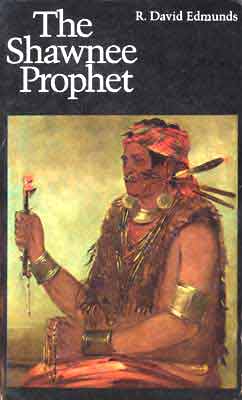 The
Shawnee Prophet
The
Shawnee Prophet
by R. David Edmunds
(Image is from the cover of the paperback edition.)
The split between "what made it into the books," and "other stuff that was also important," is explored in other books on the Archive bookshelf. In Native Roots, for instance, Jack Weatherford introduced us to the vision of Deganawidah, buried in plain sight on our coinage, hidden behind the stories about Hiawatha.
Although texts and encyclopedias have provided some information about Tenskwatawa, Edmunds does a fine job of clarifying the critical role that "The Prophet" played in the resistance to European expansion in the Northwest in the period between the Revolutionary War and the War of 1812.
Identification of patterns plays a large role in exploring the hidden history of the continent. And the reader will find rich grist for that mill in this book, especially when considering the actions and motivations of "Mad Anthony" Wayne and William Henry Harrison in light of the later career of "Autie" Custer.
The back cover of the paperback edition says:
"In the early 1800's, when control of the Old Northwest had not yet been assured to the United States, the Shawnee leaders Tecumseh and his brother Tenskwatawa, the Shawnee Prophet, led an intertribal movement culminating at the Battle of Tippecanoe and the Battle of the Thames. Historians have portrayed Tecumseh, the war leader, as the key figure in forging the intertribal confederacy. In this first full-length biography of Tenskwatawa, R. David Edmunds shows that, to the contrary, the Shawnee Prophet initiated and for much of the period dominated the movement, providing a set of religious beliefs and ceremonies that revived the tribes' fading power and cohesion.
"This volume is a valuable contribution to the history of Indian-white relations. . . . Edmunds, author of a prize-winning history of the Potawatomis, has a thorough grasp of the sources and this account is not likely to be revised by the discovery of new materials. . . . He is. . .adept in portraying the circumstances among the midwestern tribes which inspired the transformation of Lalawethika, the village drunkard, into Tenskwatawa, the Prophet. . . . It all is presented in a smooth and felicitous style which makes unobtrusive the solid scholarship on which it is based."—William T. Hagan, State University of New York at Fredonia.
"A splendid biographical study of Tenskwatawa, the Shawnee Holy Man who is best known as the brother of Tecumseh... Based upon extensive and meticulous research, this biography is a joy to read.....The author convincingly establishes the critical and pre-eminent role of Tenskwatawa as the leader of the Indian resistance to American expansion before 1810."—W. David Baird, Journal of the West.
"A fine book. The author gives balanced consideration to the individual, his people, and his times. Tenskwatawa's story is told in the context of the increasing American pressure upon Indian lands, disruption of Shawnee society and culture, inter- and intratribal politics, and British influence among the tribes in a period of mounting international tension."—Herman J. Viola, Pacific Historical Review.
"R. David Edmunds is a professor of history at Indiana University. His other publications include The Potawatomis: Keepers of the Fire (1978) and Tecumseh and the Quest for Indian Leadership (1984)."
The hardcover edition of The Shawnee Prophet is presently out-of-print. We offer the paperback edition at $16.95 US plus shipping and handling.
![]() (We
are currently refurbishing and expanding these shelves and changing over to a
completely integrated payment system for our customers, but we will be happy to
honor orders received by e-mail during this interim. Click
button to send us your orders or comments.)
(We
are currently refurbishing and expanding these shelves and changing over to a
completely integrated payment system for our customers, but we will be happy to
honor orders received by e-mail during this interim. Click
button to send us your orders or comments.)
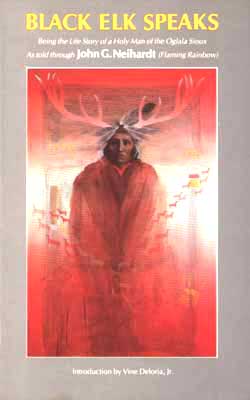
Black Elk Speaks
Being the Life Story of a Holy Man
of the Oglala Sioux
as told through John G. Neihardt
(Cover image is from the 1988 7th Printing)
For a lot of people this book has been the starting point for their exploration of the old ways. In many ways, it was a first.
To appreciate the importance of this book, first published in 1932, you have to remember that the ceremonies and practices, and especially the public statement by Nicholas Black Elk that he was a medicine man, were illegal. These things were just not discussed in public, let alone in writing, until well after 1978.
There was a very good reason for this. Followers of the traditions could be, and were, imprisoned, deprived of allotments, placed in insane asylums, and sometimes killed. Native people had learned the hard way that following their culture, practicing their spiritual traditions and speaking their language could get white people extremely excited, in very negative and permanent ways. The courage and sincerity of belief this book represents are incredible.
In his introduction to the more recent editions, Vine Deloria, Jr., has said that Black Elk Speaks, When the Tree Flowered, and The Sacred Pipe are "the basic works of the Black Elk theological tradition... Certainly in Black Elk's visions we have a natural relationship to the rest of the cosmos devoid of the trial-court paradigm but incorporating the theme of sacrifice so important to all religions in a consistent and comprehensive way."
That is certainly true, but it may be a little top-lofty for some of us. At the same time, Black Elk tells some ripping good stories that let us into a little of what it was like to be a child in the 1860's, a teenage man at the time of the Custer Fight, a participant in Buffalo Bill's Wild West Show, and a resident of the reservation in South Dakota during the first 30 years of the Twentieth Century. His description of the role his visions played, and how such things were viewed by the people, allows the perceptive reader to begin an inferential ellipse that will be new to many. One of the key elements of Black Elk's vision, for instance, resonates with Deganawidah's Good Mind and the Great Tree of Peace discussed in the last chapter of Jack Weatherford's Native Roots. Information about daily life, hunting and distribution practices, the role of the unseen and many other things are also here.
The back cover of the 1988 7th Printing said, in part:
" 'The experience of Black Elk . . . comes to one great statement, which for me is a key statement to the understanding of myth and symbols.'—Joseph Campbell in an interview with Bill Moyers, The Power of Myth."
"His meeting with the Sioux holy man Black Elk, John G. Neihardt once said, was the most memorable experience of his life. In 1930, while working on the concluding poem of his Cycle of the West, Neihardt had gone to the Pine Ridge Reservation hoping to find 'some old medicine man who had been active in the Messiah Movement and who might be induced to talk with me about the deeper spiritual significance of the matter.' In Neihardt, Black Elk recognized the one who had been sent to learn what 'was given to me for men.' The next summer, in a long series of talks, Black Elk imparted his own life story and the story of the Oglala Sioux during tragic decades of the Custer battle, the ghost dance, and the Wounded Knee Massacre."
The back cover of the 2000 edition says:
"Named one of the ten best spiritual books of the twentieth century, Black Elk speaks is the acclaimed story of Lakota visionary and healer Nicholas Black Elk (1863-1950) and his people during the momentous twilight years of the nineteenth century. Black Elk grew up in a time when white settlers were invading the Lakotas' homeland, decimating buffalo herds, and threatening to extinguish the Lakotas' way of life. Black Elk and other Lakotas fought back, a dogged resistance that resulted in a remarkable victory at the Little Bighorn and an unspeakable tragedy at Wounded Knee.
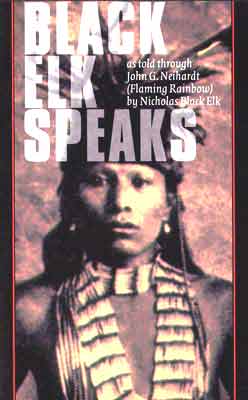
"Beautifully told through the celebrated
poet and writer John G. Neihardt, Black Elk Speaks offers much
more than a life story. Black Elk's profound and arresting religious visions of
the unity of humanity and of the world around him have transformed his account
into a venerated spiritual classic. Whether appreciated as a collaborative
autobiography, a history of a Native American nation, or as an enduring
spiritual testament for all humankind, Black Elk Speaks is
unforgettable.
(The cover image is from the 2000 edition. It is a detail from a photograph of Black Elk while he was touring Europe with Buffalo Bill's Wild West show, as a young man.)
"This special edition features all three prefaces to Black Elk Speaks that John G. Neihardt wrote at different points in his life, a map of Black Elk's world, a reset text, a listing of Lakota words newly translated and reproduced using the latest orthographic standards, and color paintings by Lakota artist Standing Bear that have not been widely available for decades."
![]()
The hardcover edition of Black Elk Speaks is available by special order at $45.00 and is usually stocked in small quantities. The paperback edition is available for $12.95.
![]() (We
are currently refurbishing and expanding these shelves and changing over to a
completely integrated payment system for our customers, but we will be happy to
honor orders received by e-mail during this interim. Click
button to send us your orders or comments.)
(We
are currently refurbishing and expanding these shelves and changing over to a
completely integrated payment system for our customers, but we will be happy to
honor orders received by e-mail during this interim. Click
button to send us your orders or comments.)
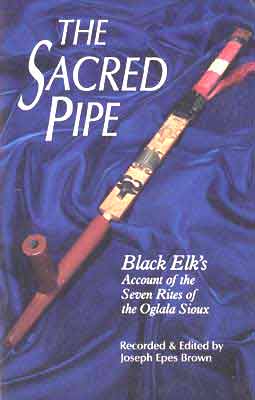
The Sacred Pipe
Black Elk's Account of the
Seven Rites of the Oglala Sioux
Recorded and Edited by Joseph Epes Brown
(Cover Image is from the cover of the 1989 softbound edition)
Fifteen years passed after the first publication of Black Elk Speaks and the sharing of his vision of the "flowering tree." It turns out he was waiting for another man.
During the winter of 1947-48, Joseph Epes Brown was invited to live with Nicholas Black Elk and his family on the Pine Ridge Reservation in South Dakota. This book, first published in 1953, contains Black Elk's words as recorded and edited.
Black Elk Speaks places his visions within the context of his life and times. Against that backdrop, The Sacred Pipe provides information about the Seven Sacred Rites that were alluded to in the earlier book. The first of these, "keeping of the soul," was given with the gift of the Sacred Pipe by the White Buffalo Calf Pipe Woman. The remaining rites were promised at that time and revealed in visions.
Black Elk Speaks gives the reader a description, through stories, of his personal world and visionary world, set against the history of the times in which he lived. In The Sacred Pipe, the reader is introduced to his symbolic world. It is possible for people to read this second book as a "how-to" for Lakota ways, but if you do so, it is pretty easy to get submerged in practices and lose sight of the beauty and meaning that he moved through. More about the "how-to" approach later.
The reader will have a richer experience if they also pay attention not just to "what" is done, but also "why" it is done, "what it means", and how the words gradually reveal the way the world looks from Black Elk's eyes. Native Americans are careful to point out that these ways are not a "religion," but rather a way of life. You do not "go" to church. In a way your life is a church—and a prayer. All of it.
If you are going to live your life, as best you can, in harmony and balance with nature on that day and the people and events that occur, you open yourself to the small miracles that happen endlessly around us. But miracles and wisdom are often offered to us symbolically. This very wise man offers us the gift of the meanings given to him.
It is a very rich gift.
The back cover of the softcover edition says:
"This is a faithful transcription by Mr. Brown of the words of Black Elk, the last of the Sioux holy men to know his tribe's religious rites, together with their history and significance. . . . Mr. Brown lived with Black Elk on the reservation, and the holy man, in order to preserve the Siouan rites both for the whites and for his own people, told him all he knew of the rites." —Saturday Review.
"Mr. Brown brought to his task genuine respect for the vanishing culture of the Sioux and for the values of their religious system." —Library Journal.
"His admiration for Black Elk and his people is obvious. . . . he has done a fine job producing a book that is a valuable contribution to American Indian literature." —San Francisco Chronicle.
"Joseph Epes Brown is a graduate of Haverford College with an M.A. in Anthropology from Stanford University and the Ph.D. in Anthropology and History of Religions from the University of Stockholm."
The hardcover edition of The Sacred Pipe is presently out-of-print. The paperback edition is available for $12.95 (US).
![]() (We
are currently refurbishing and expanding these shelves and changing over to a
completely integrated payment system for our customers, but we will be happy to
honor orders received by e-mail during this interim. Click
button to send us your orders or comments.)
(We
are currently refurbishing and expanding these shelves and changing over to a
completely integrated payment system for our customers, but we will be happy to
honor orders received by e-mail during this interim. Click
button to send us your orders or comments.)
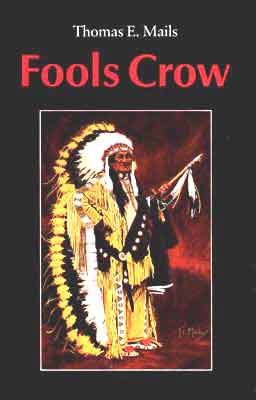
Fools Crow
by Thomas E. Mails,
Frank Fools Crow and Dallas Chief Eagle
(Cover image is from the softcover edition)
Nicholas Black Elk had been born in the early 1860's in the Little Powder River Country west of the Black Hills, and lived on the Pine Ridge Reservation just southeast of the Hills in the late 1800's and the Twentieth Century.
His nephew, Frank Fools Crow was born about 30 years later (early 1890's) on Pine Ridge and lived there for most of his life.
During a "vision quest" at Bear Butte in 1965, Fools Crow had received spiritual guidance that he was to tell certain things about himself and his people to a man who would be made known to him.
In August of 1974, the first traditional trade fair in eighty years was held at the Lower Brule Reservation, along the Missouri River in South Dakota. A writer and artist from California named Thomas Mails was invited to attend this event by Charles Ross, the Superintendent of Schools at the reservation. Mails and Fools Crow were introduced, and Fools Crow invited Mails to visit him after the event. Fools Crow was in his eighties at the time. At their next meeting, Fools Crow told Mails that he was the one Wakan Tanka had foretold. Dallas Eagle Chief agreed to act as translator for the project. This book was the result, first published in 1979.
After introducing himself to the reader, Mails somehow manages to sketch in over 200 years of information about the "Siouan" people (the Dakota) in 20 pages. Frank Fools Crow's story begins on page 32. No one who reads the rest of this book will ever think of "medicine men" the same way again.
Popular American literature, both fictional and reportage, have made a great deal of mileage out of the ridicule of traditional healers and wise people, painting them as charlatans and worse. The reader can choose to question some of the healings described by Fools Crow or not, but the essential qualities of the man and the clarity of his observations are unquestionable. The adjective that comes most readily to mind is "saintly."
But spiritual ways are not the sole concern of Fools Crow's story. The pictures he paints of the way of life during the first 70+ years of the last century, the effects of U. S. "Indian Policy," and the personal and symbolic life of his people were the first window into this submerged American heritage for many people.
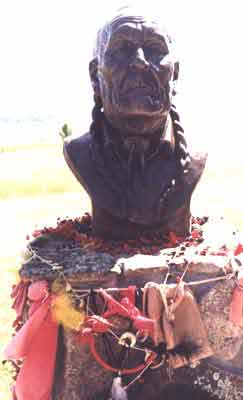
Frank Fools Crow went on ahead near the end of 1989. You can visit a beautiful sculptured bust of him at Bear Butte State Park near Sturgis, South Dakota, where he fasted and prayed many times. His words and gifts continue to enrich us all here in America.
The back cover of the softcover edition of this book says:
"Frank Fools Crow, a spiritual and civic leader of the Teton Sioux, spent nearly a century helping those of every race. A disciplined, gentle man who upheld the old ways, he was aggrieved by the social ills he saw besetting his own people and forthright in denouncing them. When he died in 1989 at the Pine Ridge Reservation in South Dakota, he was widely loved and respected.
"Fools Crow is based on interviews conducted in the 1970's. The holy man tells Thomas E. Mails about his eventful life, from early reservation days when the Sioux were learning to farm, to later times when alcoholism, the cash economy, and World War II were fast eroding the old customs. He describes his vision quests and his becoming a medicine man. His spiritual life—the Yuwipi and sweatlodge ceremonies, the Sun Dance, and instances of physical healing—is related in memorable detail. And because Fools Crow lived joyfully in this world, he also recounts his travels abroad and with Buffalo Bill's Wild West show, his happy marriages, his movie work, and his tribal leadership. He lived long enough to mediate between the U.S. government and Indian activists at Wounded Knee in 1973 and to plead before a congressional subcommittee for the return of the Black Hills to his people.
"Thomas E. Mails is also the author of Mystic Warriors of the Plains (1972) and Sun Dancing at Pine Ridge and Rosebud (1978). His art has been exhibited throughout the West."
The hardcover edition of Fools Crow is presently out-of-print. The paperback edition is available for $13.95.
![]() (We
are currently refurbishing and expanding these shelves and changing over to a
completely integrated payment system for our customers, but we will be happy to
honor orders received by e-mail during this interim. Click
button to send us your orders or comments.)
(We
are currently refurbishing and expanding these shelves and changing over to a
completely integrated payment system for our customers, but we will be happy to
honor orders received by e-mail during this interim. Click
button to send us your orders or comments.)
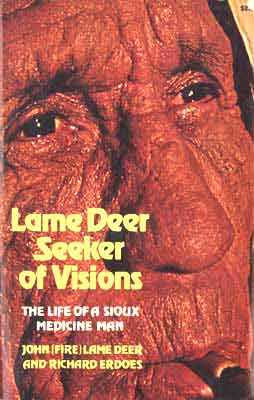
Lame Deer—Seeker of
Visions
by John Fire Lame Deer and Richard Erdoes
(Cover image is from the 1972 paperback edition.)
Lame Deer was born between the Pine Ridge and Rosebud reservations about ten years after Frank Fools Crow, around 1902.
Although Fools Crow was older, Lame Deer's book was published first, in 1972, six years before the passage of the 1978 American Indian Religious Freedom Act and seven years before Fools Crow was released. Lame Deer dedicated his book to Fools Crow and some of the other people whose books are in this collection, and the recollections that were recorded by Erdoes were often taken from group discussions that included other traditional men. This means that the reader also hears the voices of Pete Catches, Leonard Crow Dog and others.
It had been 40 years since Black Elk Speaks and nearly 20 since The Sacred Pipe. Nicholas Black Elk's words had first become available at a time that America's body was in pain from the Great Depression that had begun with the Stock Market Crash of 1929. Generations had passed when Lame Deer, Seeker of Visions appeared. Now, it was America's heart that was being broken, by Vietnam and, soon, Watergate. The country was grappling with the tasks of institutionalizing the legacy of the civil rights struggles of the Sixties, after passing through the "Summer of Love" and generational conflicts cast into focus by things like the 1,742 performances of the musical "Hair" (between 1968 and its closing in 1972), and the music of the times.
A lot of people found Black Elk after reading one of the much-thumbed copies of Lame Deer that were passed from hand to hand. For some it was the other way around, but there is no question that he and Erdoes opened another door into American history, traditional philosophy, spirituality and ethics, and the realities of the American West.
It came at a good time. And it still reads as freshly 30 years later as it did then, reminding us of things we may have lost somehow in the Eighties and Nineties.
For some of us, the greatest gift that John (Fire) Lame Deer made, however, was the lesson that medicine men have a startling and delightful sense of humor. Sprinkled through Black Elk and (later) Fools Crow's words that emerged from translation are moments when one senses the twinkle in their eyes. Lame Deer, on the other hand, describes the night that he and Erdoes shared with Korczak Ziolkowski at the Crazy Horse Monument in the summer of 1971. There are those of us who would give a lot to have been there as the three sang:
"If I had the balls of a bison,
And the prick of a bull buffalo
I'd stand on top of Crazy Horse Mountain,
And piss on the bastards below."
(It must be noted that, "Driving back to our campsite John and I (Lame Deer) agreed that we still did not like Korczak's project, but that we liked Korczak, the man.")
This brings us to Lame Deer's second great gift, that apparently conflicting opinions and conduct have a place within a greater balance that is the true work of the individual. He certainly does not come out and say this directly. That would be left to later teachers and healers, some of whom are included in the dedication to his book. What he does say is "The find-out, it has lasted my whole life. In a way I was always hopping back and forth across the boundary line of the mind."
There used to be words in common use for lovable rogues, like "scamp" and "rascal." They would certainly apply to Lame Deer, particularly in his earlier years. He tells these kinds of stories on himself, recounting foolish acts, drinking and car-stealing his way through a blizzard in South Dakota and Nebraska and spending time in jail as a result. And without shifting gears, he will suddenly be teaching some of the most basic truths about the old ways. If you want to start to learn about the traditional way and practice of balance, you can start with Lame Deer, and his inferred teaching that one shouldn't be "too" anything, without also owning its opposite.
Mixed into this incredibly rich stew of stories and teachings are nuggets of information and philosophy that seem almost to have been just thrown into the pot at random. They haven't been.
Some of us have been lucky enough to have an uncle who can be a bit of a rapscallion. He's the one who always has a new funny story, loves cut-throat pinochle, works very hard for a living, and never goes anywhere without pliers, a screwdriver and three feet of baling wire in the trunk. One minute he would talk very seriously with you, despite your young years, and the next he could pull your leg outrageously. In a lot of ways, this book is like being taught philosophy in front of a fire by that uncle (or auntie).
The back cover of the 1972 paperbound edition, as well as the most recent printing, says:
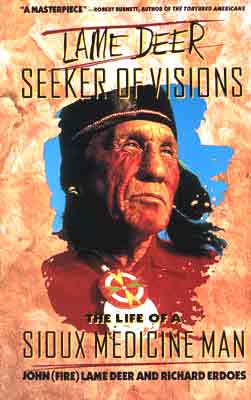
"Tahca Ushte—John Fire Lame Deer—is a full-blooded Sioux Indian born seventy-two years ago on the Rosebud Reservation in South Dakota. John Lame Deer is a medicine man, a vision seeker, a man who upholds the old religion and the ancient ways of his people. He is a man of the earth. He has been many things in his time—a rodeo clown, a soldier, a sign painter, a spud picker, a jail prisoner, a tribal policeman, a sheepherder and a singer. But above all he is a wicasa wakan, a holy man of the Lakotas."
(This cover image is from the most recent paperbound edition.)
"It's a wonderful book, and it reflects a wonderful thing that's happening. At long last, Indians are being permitted to speak and write about themselves and their peoples, and the rest of us are finding that they have—and always did have—an enormous contribution to make to our literature. Lame Deer is a magnificent American. As an individual and as a representative voice of his people, he is someone whom all readers should get to know—not just those who are interested in Indians, but every American. The book is destined to become a classic. It will be read, and reread, and quoted from through the years. Personally, I am enormously enriched by it." —Alvin M. Josephy, Jr., author of Indian Heritage of America; editor of American Heritage's Indians.
The hardcover edition of Lame Deer,
Seeker of Visions is presently out-of-print.
The paperback edition is available for
$13.00 (US).
![]() (We
are currently refurbishing and expanding these shelves and changing over to a
completely integrated payment system for our customers, but we will be happy to
honor orders received by e-mail during this interim. Click
button to send us your orders or comments.)
(We
are currently refurbishing and expanding these shelves and changing over to a
completely integrated payment system for our customers, but we will be happy to
honor orders received by e-mail during this interim. Click
button to send us your orders or comments.)
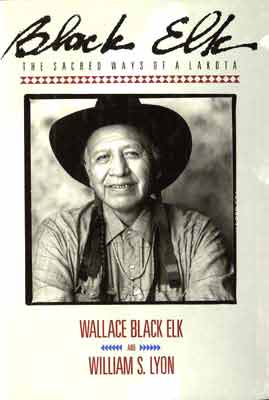
Black Elk — The
Sacred Ways of a Lakota
by Wallace Black Elk and William S. Lyon
(Cover image is from the 1990 first hardcover edition.)
In 1972, John Fire Lame Deer dedicated Lame Deer, Seeker of Visions to ten named "medicine men of the Sioux Nation." First on the list was Frank Fools Crow. Another was Wallace Black Elk.
He was born in 1921 on the Rosebud Reservation. When he was four days old his relatives asked a Scotch-Irish cowboy named Wallace Howard to give him his first name. Wallace Howard had been raised by the baby's grandfather. He understood and participated in the old ways, and also understood the significance of the request. He gave Wallace Black Elk his name, his horse, saddle, kit and rifle, and a prediction that the boy would become a bronc rider. Later, he gave him his companionship, the Irish language, and a number of relatives.
So far as we know, Wallace is not related to Nicholas Black Elk (Black Elk Speaks). We've been told that if you go back to the Lakota words that make up the true names of these two men, they are different, although they both refer to the Elk Nation. And we've never known Wallace to make a claim of blood kinship. Wallace does include Nicholas among the eleven "grandfathers" who taught him, but "grandfather" and "uncle" are often words of non-biological kinship in Dakota culture.
During World War II, he led a squad of infantry scouts through the campaigns in Africa, Italy and Germany. He brought all of them home after the war. Some of the subsequent events in his life are included in the book. During the 1980's and 1990's he lived in Denver and he travels widely.
The reader has to shift into a different set of gears to read his book. William Lyon notes in the preface that, "Wallace thinks in Lakota and translates, as he speaks, directly into English. . . . (T)he organization of his thoughts follows the Lakota pattern of making a point from many different angles, in contrast to our style of holding to one subject. Therefore, when you hear him speak, his thoughts seem to circle about. He drifts along, and, if you don't sense the point being made, you often wonder what he is talking about. The real gap, however, is not so much between the Lakota and English languages as between sacred and profane levels of being. In Black Elk's world, spirits are more real than matter."
This is true. If the reader tries to impose his own sense of order on these words, not only will he or she become confused, they will also miss the richness of the message. Although the words are set in type, these are really "recorded" conversations. It's better to play the words in your head as if you were listening, rather than reading. In a very real sense, the reader has been invited through the back door into the kitchen of a small house in Denver, past the lodge poles in the back yard, for some time over coffee. One would not try to put their own rules on such a conversation, but would concentrate on the experience. The same applies to reading the book. It takes a little work, but it is a very rich experience, indeed.
If you plan to select only one book from the Archive bookshelf, this probably isn't the one we would recommend. You need to bring some already-held knowledge to Wallace's table. If you plan to read more than two, this would be an excellent addition to your list.
The jacket of the hardcover first edition said:
"At age five, Wallace Black Elk encountered spirits during a sacred ceremony. They came to him first as lightning, then as rattling gourds, and finally as an eagle. Tossed through the roof and transported into outer space by these spirits, he saw the sun and the planets of our solar system, and was given a message: 'When you return to Earth, tell your people to love each other and stay behind this sacred Chanunpa [the Sacred Pipe].' Guided by his spiritual elders, Wallace was initiated into the ways of the Chanunpa. This book—a personal look at Native American sacramental life from the 'soul-keeping ceremony' to the Sun Dance—is a record of one man's practice. In it Wallace reveals his philosophy and rules for using the Chanunpa to bring wisdom, health, and help to all life."
"Transcribed by anthropologist William S. Lyon, this engaging first-person account captures Wallace Black Elk's humor, charm, and unique worldview. It interweaves his spiritual experience of the Chanunpa—a channel to divine and earthly wisdom—the sweat-lodge, and the vision quest with a lively account of growing up Native American."
" 'I was the first to be handpicked and trained in these powers by my grandfathers and grandmothers,' states Black Elk. 'My grandfather used to warn me, ' 'Now you are getting to that point. So don't be asking for mink coats, diamonds, and things like that. It's not that way.' ' So my grandfather was really smart. . . . He never went to school, yet he understood everything. So we have a chance to use this power to overcome evil in the world. . . . The evil itself has no power. . . . It comes from us. It crawls and creeps into our brains. We twist our own minds. We take that sacred knowledge and use it to fashion a gun. Then we call that knowledge power. So there is all this traffic between our ears, and that is where the evil comes from.' "
"Here he speaks of Tunkashila, the Great Spirit, and of the Earth Mother. He describes many of his amazing experiences and the mystical beings encountered through the sweat-lodge and the Chanunpa ceremonies. His matter-of-fact style immerses readers in a reality where the boundaries of mind, spirit, and matter are broken. Trees communicate and ghosts walk, while those who honor the old ways can tap vital energies and speak with eagle, thunder, or wind spirits."
(From the back cover:)
"Wallace Black Elk, a Lakota elder and shaman, was born in 1921 on the Rosebud Reservation in South Dakota. He has traveled widely throughout North America, Europe, and Asia, lecturing and conducting healing ceremonies. William S. Lyon, Ph.D., has taught at Southern Oregon State College and was a research associate at the University of California, Berkeley. He has worked with Wallace Black Elk for over twelve years."
"This important narrative of a Lakota medicine man's life and initiation is a powerful evocation of the human spirit born from the experience of suffering and wisdom. Grandfather Black Elk is a shaman who has bridged many worlds in the course of his long lifetime. Both the personal story of Black Elk and the teachings woven into the narrative are a rare gift to contemporary western peoples." —Joan Halifax, Ph.D., president, Ojai Foundation.
"Gives us the rare opportunity of being introduced to one of the purest and most powerful forms of shamanism. . . . Black Elk speaks directly to the reader." —Ruth-Inge Heinze, author of Shamans of the Twentieth Century.
"A story of great charm, excellently caught by William Lyon. . . . Wallace Black Elk shows us how he can join his affinity to the traditional spiritual Lakota world with life in modern civilization." —Ake Hultkrantz, author of Religions of the American Indians.
The hardcover edition of Black Elk,
The Sacred Ways of a Lakota is presently out-of-print.
The paperback edition is available for
$14.00. (US)
![]() (We
are currently refurbishing and expanding these shelves and changing over to a
completely integrated payment system for our customers, but we will be happy to
honor orders received by e-mail during this interim. Click
button to send us your orders or comments.)
(We
are currently refurbishing and expanding these shelves and changing over to a
completely integrated payment system for our customers, but we will be happy to
honor orders received by e-mail during this interim. Click
button to send us your orders or comments.)
Crow Dog
Four Generations of Sioux
Medicine Men
by Leonard Crow Dog and Richard Erdoes
(Cover image is from the 1996 softcover edition.)
Leonard Crow Dog is another of those to whom John Fire Lame Deer dedicated his 1972 book, Lame Deer, Seeker of Visions. Crow Dog was 30 years old at that time. Fittingly enough, 23 years after Lame Deer's book, Richard Erdoes also helped Crow Dog tell his story.
We regard this as a capstone book. Before reading this one, it would be a good idea to read Black Elk, or Lame Deer, or Fools Crow, as well as one or more of Vine DeLoria's works that will be added to the next bookshelf offered here at the Archive Project. This one ties all the threads together. It can certainly be read by itself, but you will miss a huge chunk of the experience if you haven't done a little reading and a lot of thinking first.
The threads are from the spiritual traditions of the continent, passed down to Crow Dog from more than three previous generations, and passed on by him to the next. They are also the threads to be gathered and inferred from both the formal and hidden history of this place and the things it has seen.
Other works on the bookshelf are haunting, and lyrical, and inspiring, and a great deal more. Leonard Crow Dog's words are all of this. But they can also be shattering. Please don't think that his words can be read at one sitting. They are too powerful, and they deserve more.
There are many things here that you won't find elsewhere. One of the most significant is the attention and honor brought by Crow Dog to "medicine" women in particular, and strong native women in general. Female practitioners of these ways have been largely passed by, in the literature. Although mentioned in other works, their contributions are often referred to in a sort of code—"a strong woman who kept the old ways," for instance. Leonard is specific. He talks about the role of "women's medicine" in physical healing, such as child birth. He also talks about attendance at a purely spiritual ceremony conducted by a woman. He also pays tribute to the contributions and sacrifices of women on the road to (and from) Wounded Knee with specific names and events.
Although he does not specifically address the point, he also makes it clear that there have been many, many "medicine" people who never had a book, but kept the old ways alive through their individual visions and ways. There have, after all, only been a few men who have been guided to share things from their traditions with us. "Women's Ways" have not been shared.
And very few have been so quietly eloquent about the most powerful and significant among those who have followed these ways—the ikche wichasha—"the wild, natural human beings." Come to think about it, it might be a good idea to also read Jack Weatherford's Savages and Civilization before tackling Leonard Crow Dog's book. You will never read history, and historical documents like old newspapers and texts, the same way again. We promise.
The back cover of the softcover edition says:
"I am Crow Dog. I am the fourth of that name. Crow Dogs have played a big part in the history of our tribe and in the history of all the Indian nations of the Great Plains during the last two hundred years. We are still making history."
"Thus opens the extraordinary and epic account of a Native American clan. Here the authors tell a story that spans four generations and sweeps across two centuries of reckless deeds and heroic lives, and of degradation and survival.
"The first Crow Dog, Jerome, a contemporary of Sitting Bull and Crazy Horse, was a witness to the coming of white soldiers and settlers to the open Great Plains. His son, John Crow Dog, traveled with Buffalo Bill Cody's Wild West Show. The third Crow Dog, Henry, helped introduce the peyote cult to the Sioux. And in the sixties and seventies, Crow Dog's principal narrator, Leonard Crow Dog, took up the family's political challenge through his involvement with the American Indian Movement (AIM). As a wichasha wakan, or medicine man, Leonard became AIM's spiritual leader and renewed the banned ghost dance. Staunchly traditional, Leonard offers a rare glimpse of Lakota spiritual practices, describing the sun dance and many other rituals that are still central to Sioux life and culture."
"Leonard Crow Dog was born in 1942 on the Rosebud Reservation in South Dakota, where he still lives."
"Richard Erdoes has written or coauthored over a dozen books, including Lakota Woman and Ohitika Woman. He lives in Santa Fe, New Mexico."
The hardcover edition of Crow Dog,
Four Generations of Sioux Medicine Men is presently out-of-print.
The paperback edition is available for
$13.00 (US).
![]() (We
are currently refurbishing and expanding these shelves and changing over to a
completely integrated payment system for our customers, but we will be happy to
honor orders received by e-mail during this interim. Click
button to send us your orders or comments.)
(We
are currently refurbishing and expanding these shelves and changing over to a
completely integrated payment system for our customers, but we will be happy to
honor orders received by e-mail during this interim. Click
button to send us your orders or comments.)